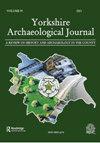The Late Medieval Cistercian Monastery of Fountains Abbey, Yorkshire: Monastic Administration, Economy, and Archival Memory
IF 0.2
0 ARCHAEOLOGY
引用次数: 2
Abstract
terms of these debates (e.g., res, res sacramenti, signum) would have helped clarify the ways that medieval and early modern people understood these images in relation to one another. Moreover, the relationship between relics and miraculous images would have also benefited from more discussion; they are only briefly noted in the introduction, in which Balzamo writes that figural representations (that are considered to be miraculous) actually overtake relics in terms of importance at the end of the Middle Ages (33). In sum, L’image miraculeuse is an excellent volume for anyone working on this broad topic and specifically for scholars and teachers who are looking for a well-organized and synthetic account of the history of miraculous images in European Christianity. For those teaching at Francophone universities, I could easily imagine multiple essays in this volume being appropriate for both undergraduate and graduate students, specifically Balzamo’s introduction and those case studies I have cited above. Although it cannot stand alone as a new definitive history on this topic given its focus on particular media and places, it productively contributes to our ongoing understanding of the history of miraculous images, the ways we might sensitively approach their study today, and what they might have in common across a historically expansive period of time.约克郡喷泉修道院的中世纪晚期西多会修道院:君主管理、经济和档案记忆
这些争论的术语(例如,res、res sacrameti、signum)将有助于澄清中世纪和早期现代人理解这些图像的方式。此外,文物和神奇图像之间的关系也会从更多的讨论中受益;巴尔扎莫在引言中写道,在中世纪末,人物形象(被认为是奇迹)的重要性实际上超过了遗迹(33)。总之,对于任何从事这一广泛主题工作的人来说,尤其是对于那些希望对欧洲基督教中奇迹图像的历史进行有组织、综合的描述的学者和教师来说,《L’image mirculeuse》是一本优秀的书。对于那些在法语大学任教的人来说,我可以很容易地想象这本书中的多篇文章适合本科生和研究生,特别是巴尔扎莫的引言和我上面引用的案例研究。尽管鉴于它对特定媒体和地点的关注,它不能单独作为一部关于这一主题的新的权威史,但它有助于我们持续了解奇迹图像的历史,我们今天可能敏感地处理它们研究的方式,以及它们在历史上广阔的一段时间内可能有什么共同点。
本文章由计算机程序翻译,如有差异,请以英文原文为准。
求助全文
约1分钟内获得全文
求助全文

 求助内容:
求助内容: 应助结果提醒方式:
应助结果提醒方式:


